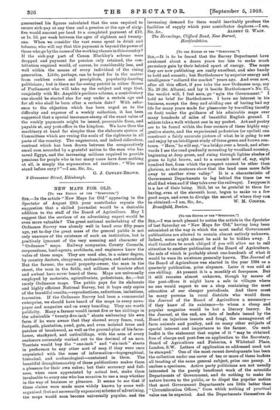NEW MAPS FOR OLD.
[To THE EBrroa OF TON " SPECTAT011.1 SIR,—In the article " New Maps for Old " appearing in the Spectator of August 29th your contributor repeats the suggestion that a skilled journalist would be a desirable addition to the staff of the Board of Agriculture. May I suggest that the services of an advertising expert would be even more valuable ? The great national undertaking of the Ordnance Survey was already well in hand over fifty years ago, yet to-day the great mass of the general public is not only unaware of the existence of such an institution, but is positively ignorant of the very meaning and character of " Ordnance" maps. Railway companies, County Councils, corporations, land-agents, architects, and engineers know the value of these maps. They are used also, in a minor degree, by country doctors, clergymen, archaeologists, and naturalists. But the farmer, the small property-owner, the man in the street, the man in the fields, and millions of tourists afoot and awheel have never heard of them. Maps are universally employed by motorists, agriculturists, pedestrians, &c.,—but rarely Ordnance maps. The public pays for its elaborate and highly efficient National Survey, but it buys only copies of the beautiful results,—reproductions, reductions, imitations, travesties. If the Ordnance Survey had been a commercial enterprise, we should have heard of the maps in every news- paper and magazine and on every hoarding. They are worth publicity. Many a farmer would invest five or ten shillings in the admirable " twenty-five-inch" sheets embracing his own farm if he were aware that they showed every fence, road, footpath, plantation, pond, gate, and even isolated trees and patches of brushwood, as well as the ground-plan of his farm- house, stackyard, and outbuildings, with the area of every enclosure accurately worked out to the decimal of an acre. Tourists would buy the " one-inch " and " six-inch" sheets in preference to any other sort of map if they were once acquainted with the mass of information—topographical, historical, and archaeological—contained in them. The beautiful draughtsmanship of these publications makes them a pleasure for their own sakes ; but their accuracy and f ull- ness, when once appreciated by actual test, make them invaluable to every one who has occasion to use a map whether in the way of business or pleasure. It seems to me that if these claims were made more widely known by some well- organised (but not necessarily expensive) scheme of advertising, the maps would soon become universally popular, and the increasing demand for them would inevitably produce the facilities of supply which your contributor deplores.—I am,






































 Previous page
Previous page